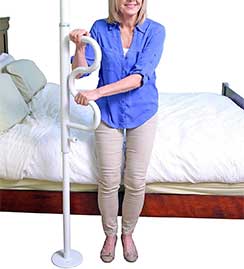Muscle weakness, poor endurance and decreased balance are some early signs that a senior may have difficulty with getting out of bed. The following senior safety equipment will explore the supportive options that can be used to help with a bed transfer.
Bed Rail
A bed rail is a transfer aid that helps seniors with getting out of bed. It is made of metal and secured to the bed frame or mattress, and some models are held in place by someone’s body weight which rests on top of the frame’s support base. The railing can be pulled on or pushed off of to reposition in bed or help a senior stand up from a seated position.
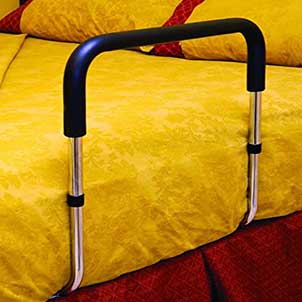

Floor to Ceiling Safety Pole
A tension mounted security pole can help someone pull themselves into a standing position. The metal shaft can be easily lengthened or shortened to achieve the right amount of simultaneous pressure on the floor and ceiling. This helps to secure the device in place to hold someone’s weight as they rise up into a standing position. Because of the securing mechanism, this senior safety equipment cannot be used on stucco ceilings as it will damage the ceiling’s appearance. Most floors tend to be suitable for a stability pole installation and it is commonly seen on carpeted areas, hardwood, laminate surfaces and other types of flooring.
Patient Transfer Belt
Following an injury or illness, transfer belts can be used in physical therapy to support rehab exercises with the intent of increasing one’s muscle strength and endurance back to normal levels. The added grasping handles on the belt allows caregivers to get a good grip during any supported bed transfer, translating to increased safety for the senior and their caregiver. This device can also serve as a gait belt that can be used by a caregiver to partially support the wearer’s weight or balance during walking or climbing stairs. A capable caregiver is required to be present to assist with any transfers.
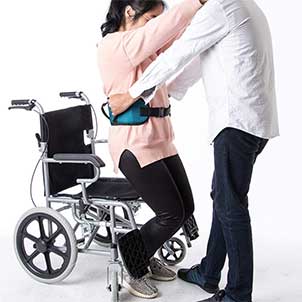

Walking Frame or Rolling Walker
When following a safe transfer technique, a walking frame can help make bed transfers easier. If one is able to grasp the top of the aluminum frame and push down, one would have an easier time getting up. This technique requires that someone have good upper body strength, and that most of their weight be placed on the rear skis or points to prevent the walking frame from sliding or rolling away. A bed transfer can also be supported by a rollator walker, however the brakes must be in the locked position prior to any transfer attempt.
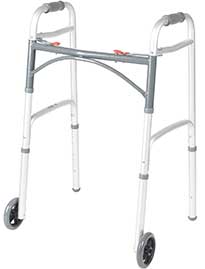

Caution: If the wheels of a rollator walker are free to move, this could lead to the rollator walker rolling forward away from you during a transfer attempt. This may result in a fall, injury or worse as one’s base of support moves further away. For this reason, it is recommended that the brakes be changed to the locked position during any transfer attempt to prevent the rolling walker from moving away.
Wall Mounted Fold Away Grab Bar
Grab bars can be placed near the bed by having them mounted into the wall near the headboard. This type of safety railing can be raised or lowered into position as needed to help someone:

- Pull themselves to a sitting position from lying down and
- Push down on the railing to get into a standing from a sitting position at the edge of the bed.
A mounted safety railing can serve as a bed rail if the bed is positioned close enough to the aid.
Tip: This senior transfer aid must be secured into studs or a mount. As a result, you may need to move the bed slightly to accommodate the grab bar’s securement spot.
Foam Bed Wedge
A foam wedge basically acts as a support cushion meant to help push someone’s upper torso forward. Sometimes this extra support can mean the difference between being able to get up or being stuck in a lying down position in bed. Also, the padding can help achieve a more comfortable sleeping position or be used to elevate one’s feet during the day. While the foam material itself is not incontinence proof, it can be covered by a washable wrap to help protect it.
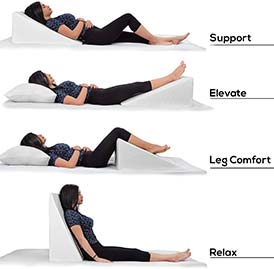

Tip: Some sufferers of acid reflux find elevating their upper body prevents acid from leaking from their stomachs into the esophagus. When elevated, it is gravity that helps to keep the damaging acid inside the stomach.
Adjustable Bed Furniture Risers
Similar to the difficulty some have with standing from a low car seat, getting out of a low bed can be just as hard. For some low bed frames, this can be counteracted with adjustable furniture risers. By placing the bed’s feet inside these stackable furniture risers, the overall height of the bed can be increased. In turn, this pushes any seated individual into a higher position and allows them to get out of bed more easily.
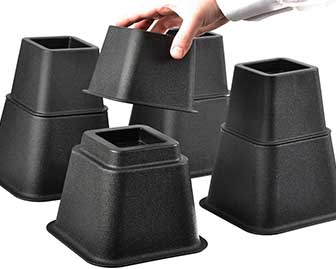

Tip: This safety equipment is not suitable for bed frames whose perimeter needs to sit flat on the floor, and should only be used for those beds that sit on feet. Also, furniture risers should not be used for beds whose base rests on top of wheels.
Patient Lift
This is a piece of equipment with a large metallic base that rests on the floor and is used to hoist someone from a lying down or seated position to move them to another surface such as a bed or nearby wheelchair. This device takes up a lot of floor space and needs clear pathways to maneuver around as they carry the senior in the sling to the bed or other surface. Training is required to safely use this equipment, and two caregivers need to be present during its operation so issues can be troubleshooted and have further assistance called if needed. Using a patient lift is not recommended on carpeted floors as it is harder to move the device and may get stuck.
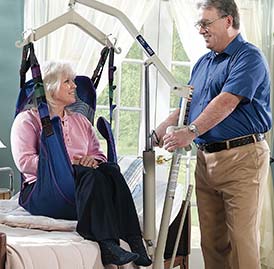

Cane or Standing Stick
For seniors with minimal difficulty standing up, a cane or standing stick can be used to push off the floor to get into standing. The simplicity of this device makes it less stable as a transfer aid given its small base of support that can be toppled over easily. As a result, one must have not only good strength to use this device, but also good balance to not fall over during a transfer attempt. For this reason, canes tend to be used by younger seniors with fewer health conditions and greater physical capabilities.
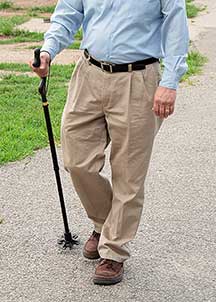

Summary: This safety device is used to move a senior from one spot to another while protecting the caregivers from back injuries. It is a common tool for those that do not have the necessary balance, muscle strength or endurance to be able to support their own weight in standing.
Ceiling Lift
An overhead motorized unit that lifts someone up from sitting or lying down with a corresponding patient sling. This device is mounted onto an overhead track that is drilled into the ceiling. This type of transfer device is expensive because it has many costs associated with installation, training on safe use, and the requirement that two caregivers be present when operating the equipment. That said, this is one of the safest ways to move someone that is very heavy and unable to help with their own body positioning or posture changes. As a result, this device tends to be mainly seen in hospitals where people are more actively sick or chronically ill with great muscle weakness and difficulty getting out of bed. That said, more consumer friendly models have popped up on the market, and many caregivers praise this tool as a way to prevent back injuries while safely moving someone.
Note: This is the most expensive option to support a patient’s transfer out of bed.
Electric Hospital Bed
Hospital beds are expensive, but they can be helpful with helping someone get out of bed. The headrest can rise to push someone’s upper body forward into a slightly more seated position. As well, the entire bed can be adjusted lower or higher to position one’s feet at the right height to gain as much momentum as possible for any standing attempt.
In the community setting, hospital beds tend to be used by palliative patients near the end of life or those with advanced medical conditions. The highly customizable nature of hospital beds allows them to take advantage of special therapeutic mattresses or other accessories to increase someone’s comfort. More importantly, the ability to adjust the bed’s position allows a caretaker to help with:
- personal care tasks while protecting the caregiver’s back from twisting and bending motions
- body repositioning or weight shifting to minimize risk of developing pressure sores and
- improve one’s overall comfort levels
Sit Up Helper
This equipment is secured near the foot of the bed and left lying beside the individual. It’s main purpose is to help someone pull themselves into an upright position by grasping the padded handles. Once sitting upright, other nearby assistive aids can then be used to facilitate a transfer away from the bed.
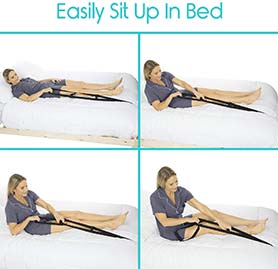

Tip: An added benefit to a sit up helper is that it can help someone reposition or shift their body while they are lying down in bed.
